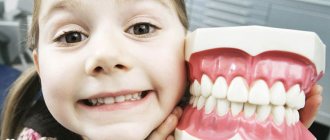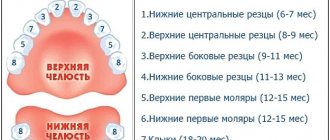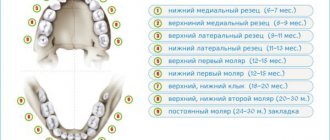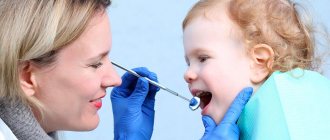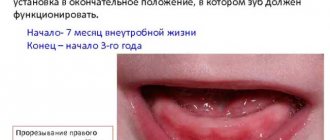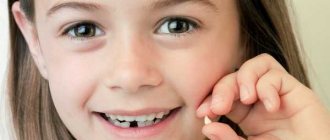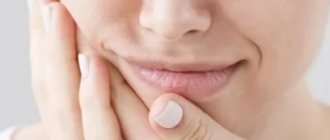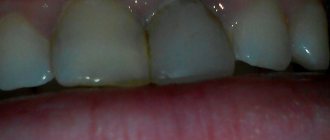How to Reduce Teething Pain
Fever and pain can be reduced by:
- massage the gums where tooth eruption is expected;
- the gums can be lubricated with an anesthetic;
- give the child a vasoconstrictor if the child has a runny nose;
- if the temperature rises above +38C, then the child should be given an antipyretic in the form of a sweet syrup.
Usually, the eruption of baby teeth occurs without complications. In some cases, a complication may occur that is caused by:
- Presence of a dental cyst.
- When the baby tooth has not yet come out, but it is supported by a permanent tooth.
- When a fang erupts, it is out of place in the dentition.
Signs of formation of permanent teeth
The most characteristic symptom of the formation of adult teeth in childhood is the growth of jaw size. The gaps between the first teeth are small; if the jaw grows, this means that it creates conditions for new dental units. Adult teeth are larger than temporary teeth, so they require a lot of space. The distance between baby teeth increases. They lose stability and fall out. With any deviations, the teeth will break through with pain, bend, and ruin the bite. In order for a child’s teeth to grow correctly, parents need to control this process.
Pay attention to the distance between your child's teeth
Permanent teeth can erupt at 6-7 years of age without any symptoms, but most often the child behaves restlessly, is capricious, gets irritated over trifles, and eats poorly. Often the formation of permanent teeth has the same signs as during the eruption of milk teeth. If other diseases occur during teething, they can distort the symptoms.
- How to make teething easier for babies
Permanent teeth erupt at 6 or 7 years of age
Increased secretion of saliva is a very common symptom, although it is no longer as abundant as in infancy, but the difference can be noticed. At the age of 6, children can already be taught to wipe their mouth with a napkin, otherwise irritation will appear on the face, since saliva contains many microbes that aggressively affect delicate skin.
If your child is drooling, have a supply of clean tissues ready.
During the period of growth of permanent teeth, the gums and mucous membranes become inflamed again. If you notice redness in the mouth, it is better to show the child to a dentist, who can accurately distinguish the beginning of teething from a banal viral infection.
Take your child to the dentist if you notice redness in your child's mouth
Over time, swelling is observed on the gums - this is an adult tooth making its way to replace the temporary one. The germination process is painful; parents can alleviate the child’s condition with anesthetics.
Pain is replaced by itching. The child pulls any things to his mouth to soothe his gums.
The child may suck or chew fingers or other objects
A natural symptom will be deterioration in sleep quality. If he is bothered by toothache, the baby will not be able to fall asleep for a long time, often wakes up at night, cries, and tosses and turns.
If your baby is having difficulty sleeping and crying, this could be a symptom of teething.
Some children develop a fever, cough, and upset stool.
Fever and cough may appear
The listed signs may appear periodically and do not necessarily have to be present in all children.
Eye teeth in older children
Permanent eye teeth erupt in children aged 9-12 years. Normal eye tooth eruption should occur painlessly. If pain still bothers the child, it may be caused by:
- the presence of infection in the oral cavity;
- periodontal disease;
- development of dental caries.
The eye teeth may erupt in a crooked manner. Orthodontic treatment helps correct abnormal tooth growth. If a tooth erupts and grows incorrectly, it is removed on the advice of a dentist. After removing an eye tooth, it must be immediately replaced with a prosthetic so as not to disrupt the integrity of the dentition and not to impair the process of chewing food.
Features in adults
Although eye teeth tend to be more of a concern for young children, adults also often have questions related to some type of canine problem.
- At what age does the replacement of primary canines with permanent ones occur? Typically, the eye teeth on the upper jaw appear a little later than on the lower jaw. The approximate age when the lower canines grow is 9-10 years, and the upper ones are 11-12 years.
- How many permanent eye teeth appear and can they erupt before the front teeth? The canines appear fifth in the permanent dentition - after the first molars (5-6 years), central and lateral incisors (6-9 years), and first premolars (10-12 years). Violation of this pattern of eruption of permanent teeth can be both an individual characteristic of a person and a sign of serious dental pathology (for example, adentia due to the death of the rudiments of permanent teeth).
- Why can an eye tooth hurt? Normally, a healthy person should not have any pain in the teeth. If the eye tooth still hurts, then this may be a sign of a serious pathology: periostitis (flux), pulpitis, periodontitis and others. In any case, you should not engage in independent treatment - it is better to consult a dentist for qualified help. The only thing you can do before visiting the doctor is take a pain reliever.
- What to do if the eye tooth has grown incorrectly? Dental anomalies in the form of crooked teeth are quite common. In some, this defect is practically invisible, but sometimes the fangs erupt at a considerable distance from their intended place. This situation can be corrected by orthodontic treatment (braces, mouth guards), but sometimes, in especially severe cases, the doctor suggests pulling out a crooked tooth to straighten the dentition.
- Is it possible to remove eye teeth? Removing any tooth is an extreme measure that the dentist will only take as a last resort. And fangs are no exception to the rule. Premature loss of a baby eye tooth can lead to the formation of malocclusion, and its removal in an adult significantly impairs the chewing function of the teeth and also negatively affects a person’s appearance. But if you still had to pull out a fang, then you should have it prosthetically installed as early as possible.
While the eye teeth are special, the importance of the rest cannot be underestimated. It is necessary to carefully monitor the condition of the oral cavity - only this will help maintain a healthy and beautiful smile until old age.
How to reduce pain in an eye tooth using traditional medicine
Dental treatment of the eye tooth can be supplemented with treatment with traditional medicine. Typically, after visiting a dentist in a specialized clinic, they advise the following:
- Dissolve a teaspoon of baking soda or salt in a glass of warm water. Rinse your mouth with this solution several times a day.
- Prepare a decoction of medicinal herbs: chamomile, sage, or make an infusion of oak bark. Rinse your mouth with prepared decoctions and infusions several times a day.
The eruption of eye teeth in children should occur under the supervision of a pediatric dentist. Adults who have problems with their eye teeth should also see a dentist.
Associated symptoms
These symptoms do not appear very often, but they cannot be ignored. If the baby has a fever, an incomprehensible cough, or diarrhea, this can be either a sign of infection or a reaction of a weakened body to pathogenic microflora.
Diarrhea can be a sign not only of teething, but also of various diseases
When teeth are forming, the temperature usually lasts for 3-4 days at 38.5°C. This symptom is irregular, so fever in children should be periodic. If it persists for a long time, you need to show the child to the pediatrician. Some doctors believe that cold symptoms have nothing to do with teething and prescribe appropriate treatment for cough and fever.
If the temperature lasts longer than three days, you should consult a doctor.
Adults also don’t understand what cough and runny nose have to do with new teeth. The gums are directly connected to the blood supply to the nose and respiratory tract. As teeth form, blood flow increases in the mouth. The nasal mucosa is close, so its glands also begin to produce more mucus, which children try to get rid of. Remaining mucus settles into the throat, irritating the airways and causing a cough.
A runny nose may occur when teething
Another symptom is loose stools with a frequency of no more than 3 times a day. While scratching his gums, the baby constantly puts dirty fingers and the first objects he comes across into his mouth. In addition to infection, diarrhea is facilitated by increased salivation, which constantly flushes the intestines. If the stool is short-lived and does not contain blood, there is no need to worry about the child’s health. It is necessary to monitor his condition, since with a weakened immune system there is always a risk of developing an infection, which aggravates all the symptoms.
What are baby teeth?
Milk teeth are the teeth that are the first to erupt in humans. Their rudiments are formed in the womb, at approximately 5-7 weeks of pregnancy, and by the age of three the child already has 20 teeth. Milk teeth differ from permanent teeth in structure (they are smaller and have a different shape), and the bite does not contain small molars, or premolars.
X-ray of baby teeth
Scheme of baby teeth eruption
Normally, baby teeth begin to appear after the child reaches 5-6 months, but this period depends on a number of factors, including the quality and characteristics of the child’s diet, the region of residence and even the weather. Some children are born with one or more teeth; most often they must be removed because they interfere with normal sucking.
On a note! Milk teeth erupt symmetrically according to the so-called antagonizing principle, that is, teeth of the same name appear approximately simultaneously, and the process begins from the lower jaw. The exception is the lateral incisors, which begin to erupt from above.
Numbering of baby teeth
First, the two lower central incisors are shown, then the two upper ones, which are located directly above them. This order of teething ensures contact between the teeth and gives the baby the opportunity to begin to practice chewing solid foods. By the age of one year, a child, as a rule, has eight teeth. Next, two fangs grow - first on the lower jaw, then on the upper, after which the teeth of the chewing group (molars) erupt. At three years old, children can already fully bite and chew solid food.
Approximate order and pattern of appearance of baby teeth
| Name | Age, months |
| Central incisors on the lower jaw | 6-7 |
| Central incisors on the upper jaw | 8-9 |
| Lateral incisors, upper jaw | 9-11 |
| Lateral incisors, lower jaw | 11-13 |
| Upper molars (first) | 12-15 |
| Lower molars (first) | 12-15 |
| Fangs | 18-20 |
| Second molars | 20-30 |
